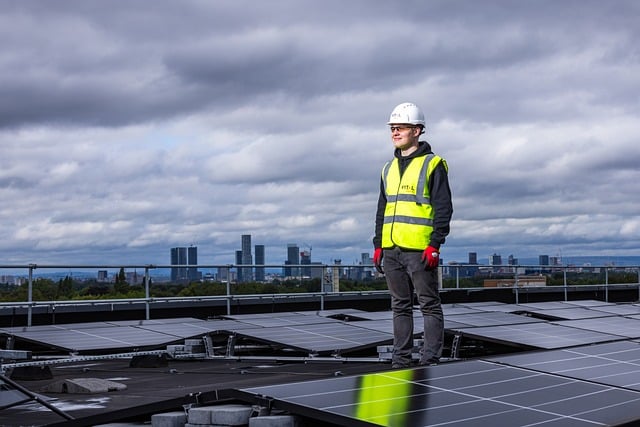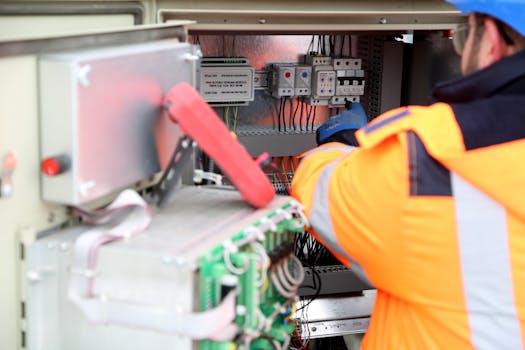“Maximize Efficiency: Avoid These Common Solar Inverter Maintenance Mistakes!”
Common solar inverter maintenance mistakes can significantly impact the efficiency and longevity of solar energy systems. Many users overlook essential maintenance practices, leading to reduced performance and potential costly repairs. Common errors include neglecting regular inspections, failing to clean the inverter and surrounding areas, ignoring warning signs or error codes, and not keeping up with firmware updates. Additionally, improper installation or placement can hinder the inverter’s functionality. By understanding and avoiding these mistakes, solar system owners can ensure optimal performance and extend the lifespan of their inverters.
Ignoring Regular Inspections
When it comes to maintaining a solar energy system, one of the most critical components is the solar inverter. This device plays a pivotal role in converting the direct current (DC) generated by solar panels into alternating current (AC) that can be used in homes and businesses. However, many solar system owners make the mistake of ignoring regular inspections of their inverters, which can lead to significant issues down the line. Regular inspections are essential for ensuring the longevity and efficiency of the inverter, and neglecting this aspect of maintenance can result in costly repairs or even complete system failure.
One of the primary reasons why regular inspections are often overlooked is the misconception that solar inverters are maintenance-free. While it is true that modern inverters are designed to be durable and reliable, they still require periodic checks to ensure they are functioning optimally. Over time, components can wear out, connections can loosen, and dust or debris can accumulate, all of which can hinder performance. By failing to conduct regular inspections, owners may not notice these issues until they escalate, leading to more extensive damage and higher repair costs.
Moreover, regular inspections allow for the early detection of potential problems. For instance, an inverter may show signs of overheating or unusual noises, which could indicate an underlying issue that needs to be addressed. By identifying these problems early, owners can take corrective action before they lead to more severe complications. This proactive approach not only saves money but also ensures that the solar energy system continues to operate efficiently, maximizing energy production and savings.
In addition to identifying issues, regular inspections also provide an opportunity to update software and firmware. Many modern inverters come equipped with advanced monitoring systems that require periodic updates to maintain optimal performance. By neglecting these updates, owners may miss out on improvements that enhance efficiency or address known bugs. Therefore, incorporating software checks into regular inspections is crucial for keeping the inverter up to date and functioning at its best.
Furthermore, regular inspections can help owners stay informed about the overall health of their solar energy system. During these inspections, technicians can assess not only the inverter but also the solar panels and other components of the system. This comprehensive evaluation allows for a better understanding of how each part interacts and contributes to the system’s overall performance. By gaining insights into the system’s health, owners can make informed decisions about future upgrades or repairs, ensuring that their investment continues to yield returns.
In conclusion, ignoring regular inspections of solar inverters is a common mistake that can have serious repercussions. By prioritizing these inspections, owners can detect potential issues early, ensure software is up to date, and gain a comprehensive understanding of their solar energy system’s health. This proactive approach not only extends the life of the inverter but also enhances the overall efficiency of the solar energy system. Ultimately, investing time and resources into regular inspections is a wise decision that pays off in the long run, safeguarding both the performance and reliability of solar energy systems.
Neglecting Firmware Updates

When it comes to maintaining solar inverters, one of the most critical yet often overlooked aspects is the importance of keeping firmware updated. Neglecting firmware updates can lead to a range of issues that not only affect the performance of the inverter but can also compromise the overall efficiency of the solar energy system. Firmware, which is essentially the software that controls the hardware of the inverter, is regularly updated by manufacturers to enhance functionality, improve efficiency, and address any security vulnerabilities. Therefore, failing to keep this software current can result in missed opportunities for optimization and increased risks.
One of the primary reasons why homeowners and businesses neglect firmware updates is a lack of awareness. Many users assume that once their solar inverter is installed and operational, it requires little to no further attention. This misconception can be detrimental, as outdated firmware may not only hinder the inverter’s performance but can also lead to compatibility issues with other components of the solar energy system. For instance, if the inverter’s firmware is not updated to support new solar panel technologies or battery storage systems, it may not operate at its full potential, resulting in lower energy production and, consequently, reduced savings on energy bills.
Moreover, manufacturers often release firmware updates to fix bugs or glitches that may have been identified after the initial release. Ignoring these updates can leave the inverter vulnerable to operational issues that could have been easily resolved. For example, an outdated firmware version might not effectively manage the inverter’s response to grid fluctuations, leading to potential damage or inefficiencies. Therefore, it is crucial for users to stay informed about available updates and to implement them promptly.
In addition to performance and efficiency concerns, neglecting firmware updates can also pose security risks. As with any technology, solar inverters can be susceptible to cyber threats. Manufacturers are aware of these vulnerabilities and often release firmware updates to patch security holes. By failing to update the firmware, users may inadvertently expose their systems to potential attacks, which could compromise not only the inverter but also the entire solar energy system. This risk underscores the importance of regular maintenance and vigilance in keeping firmware up to date.
To avoid the common mistake of neglecting firmware updates, users should establish a routine maintenance schedule that includes checking for updates. Many modern inverters come equipped with monitoring systems that can alert users when updates are available. Taking advantage of these features can simplify the process and ensure that the inverter remains in optimal condition. Additionally, users should familiarize themselves with the manufacturer’s guidelines regarding firmware updates, as these can provide valuable insights into the frequency and importance of maintaining current software.
In conclusion, neglecting firmware updates is a common mistake that can have significant repercussions for solar inverter performance, efficiency, and security. By prioritizing regular updates, users can enhance the longevity of their solar energy systems and ensure they are operating at peak efficiency. Staying informed and proactive about firmware maintenance not only protects the investment in solar technology but also maximizes the benefits of harnessing renewable energy. Ultimately, a well-maintained solar inverter contributes to a more sustainable future, making it essential for users to recognize the importance of this often-overlooked aspect of solar energy management.
Overlooking Cleaning Requirements
When it comes to maintaining solar inverters, one of the most frequently overlooked aspects is the necessity of regular cleaning. Many solar system owners tend to underestimate the impact that dirt, dust, and debris can have on the performance and longevity of their inverters. This oversight can lead to significant inefficiencies and, ultimately, costly repairs or replacements. Therefore, understanding the importance of cleaning and the common mistakes associated with it is crucial for anyone looking to maximize their solar investment.
First and foremost, it is essential to recognize that solar inverters are typically installed in outdoor environments, where they are exposed to various elements. Over time, dust and dirt can accumulate on the inverter’s surface, obstructing airflow and causing the unit to overheat. This overheating can lead to reduced efficiency and may even trigger automatic shutdowns to protect the system. Consequently, neglecting to clean the inverter regularly can result in diminished energy production, which defeats the purpose of investing in solar technology in the first place.
Moreover, many owners mistakenly believe that cleaning their solar inverters is a one-time task that can be completed during the initial installation or after a significant weather event. In reality, regular maintenance is necessary to ensure optimal performance. Depending on the local environment, cleaning may need to be performed monthly or quarterly. For instance, areas with high levels of dust or pollen may require more frequent attention, while regions with heavy rainfall may experience less buildup. Therefore, establishing a cleaning schedule tailored to the specific conditions of your location is vital.
In addition to frequency, the method of cleaning is another common pitfall. Some individuals may resort to using harsh chemicals or abrasive materials, thinking that these will provide a more thorough clean. However, this approach can damage the inverter’s surface and compromise its protective coatings. Instead, it is advisable to use a soft cloth or sponge with mild soap and water. This gentle approach will effectively remove dirt without risking harm to the unit. Furthermore, it is crucial to ensure that the inverter is powered down before cleaning to avoid any electrical hazards.
Another mistake often made is neglecting the surrounding area of the inverter. While the inverter itself may be clean, debris such as leaves, branches, or even snow can obstruct airflow and create additional heat buildup. Therefore, it is essential to maintain a clear space around the inverter, ensuring that it has adequate ventilation. This practice not only enhances the inverter’s performance but also prolongs its lifespan.
Additionally, many owners fail to consider the importance of checking the inverter’s vents and filters during the cleaning process. Dust and debris can accumulate in these areas, leading to airflow restrictions that can cause overheating. Regularly inspecting and cleaning these components can prevent potential issues and ensure that the inverter operates efficiently.
In conclusion, overlooking the cleaning requirements of solar inverters can lead to significant performance issues and increased maintenance costs. By establishing a regular cleaning schedule, using appropriate cleaning methods, maintaining the surrounding area, and checking vents and filters, solar system owners can avoid these common mistakes. Ultimately, taking the time to care for your solar inverter will not only enhance its efficiency but also extend its operational life, ensuring that your investment continues to yield benefits for years to come.
Failing to Monitor Performance Metrics
When it comes to solar energy systems, the inverter plays a crucial role in converting the direct current (DC) generated by solar panels into alternating current (AC) that can be used in homes and businesses. However, many solar system owners make the mistake of neglecting the monitoring of their inverter’s performance metrics. This oversight can lead to inefficiencies, reduced energy production, and ultimately, a decrease in the return on investment for the solar installation. Therefore, understanding the importance of monitoring performance metrics is essential for maintaining an efficient solar energy system.
One of the most common mistakes is assuming that once the solar system is installed, it will operate flawlessly without any need for oversight. This misconception can be detrimental, as inverters, like any other piece of technology, can experience issues over time. Regularly monitoring performance metrics allows owners to identify potential problems early on, ensuring that the system operates at peak efficiency. For instance, if the inverter is not converting energy as expected, it may indicate a malfunction or an issue with the solar panels themselves. By keeping an eye on these metrics, owners can address problems before they escalate, saving both time and money.
Moreover, failing to monitor performance metrics can lead to missed opportunities for optimization. Many modern inverters come equipped with advanced monitoring capabilities that provide real-time data on energy production, efficiency, and system health. By regularly reviewing this data, owners can gain insights into how their system is performing and make informed decisions about maintenance or upgrades. For example, if performance metrics indicate that energy production is consistently lower during certain times of the day, it may prompt an investigation into shading issues or the need for cleaning the solar panels. Ignoring these metrics means missing out on valuable information that could enhance the overall performance of the solar system.
In addition to identifying issues and optimizing performance, monitoring metrics can also play a significant role in warranty claims and insurance. Many manufacturers require proof of regular maintenance and monitoring to validate warranties. If a system owner fails to keep track of performance metrics, they may find themselves without coverage when a problem arises. This situation can lead to unexpected repair costs that could have been avoided with proper monitoring. Therefore, maintaining a record of performance metrics not only helps in troubleshooting but also serves as documentation for warranty purposes.
Furthermore, it is essential to understand that performance metrics can vary based on several factors, including weather conditions, seasonal changes, and system orientation. By regularly monitoring these metrics, owners can better understand how external factors impact their solar energy production. This knowledge can inform decisions about future investments, such as adding more panels or adjusting the system’s orientation to maximize sunlight exposure. Without this data, owners may remain unaware of how to adapt their systems to changing conditions, ultimately leading to suboptimal performance.
In conclusion, failing to monitor performance metrics is a common mistake that can have significant repercussions for solar energy system owners. By prioritizing regular monitoring, owners can identify issues early, optimize performance, maintain warranty coverage, and adapt to changing conditions. Embracing a proactive approach to monitoring not only enhances the efficiency of the solar system but also ensures that the investment continues to yield benefits for years to come. Therefore, it is imperative for solar system owners to recognize the value of performance metrics and incorporate regular monitoring into their maintenance routines.
Q&A
1. **Question:** What is a common mistake when cleaning solar inverters?
**Answer:** Using harsh chemicals or abrasive materials can damage the inverter; it’s best to use a soft cloth and mild soap.
2. **Question:** What maintenance task is often overlooked by solar inverter owners?
**Answer:** Regularly checking and tightening electrical connections can prevent performance issues and potential hazards.
3. **Question:** Why is it a mistake to ignore error codes on the inverter display?
**Answer:** Ignoring error codes can lead to prolonged system downtime and may cause further damage if not addressed promptly.
4. **Question:** What is a common error regarding inverter placement?
**Answer:** Installing the inverter in a location with poor ventilation can lead to overheating; it should be placed in a cool, shaded area.
Conclusion
Common solar inverter maintenance mistakes to avoid include neglecting regular inspections, failing to clean the inverter and surrounding area, overlooking firmware updates, ignoring warning signals or error codes, and not keeping records of maintenance activities. By addressing these mistakes, solar system owners can enhance the longevity and efficiency of their inverters, ensuring optimal performance and reducing the risk of costly repairs.




